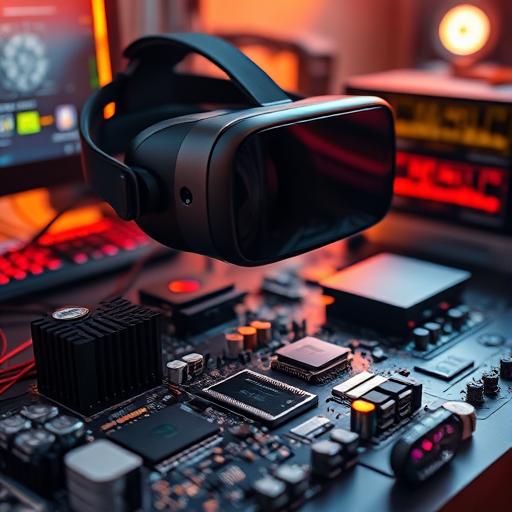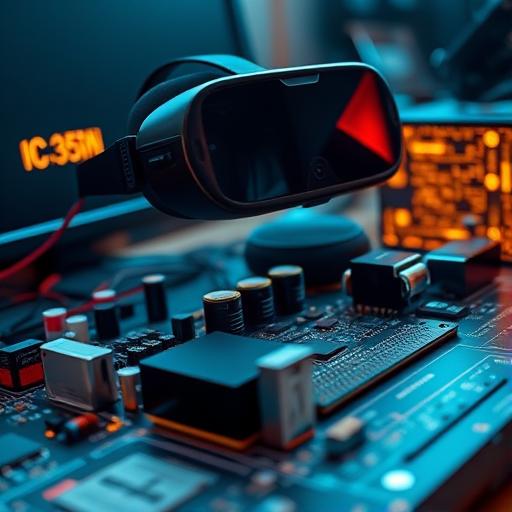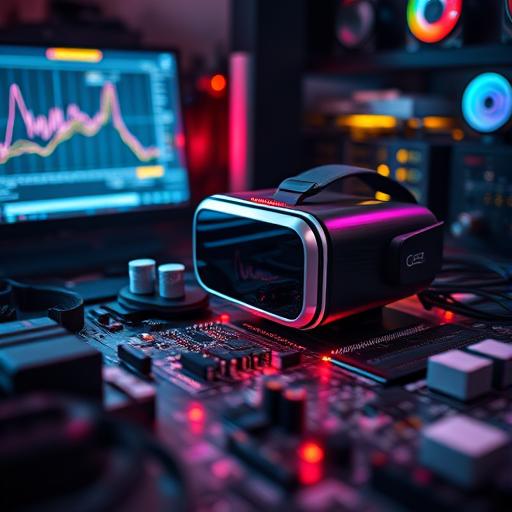Imagine interacting with your smartphone in a 3D virtual environment while sitting at home, where your living room transforms into a digital workspace or a concert venue. This isn’t science fiction—it’s the reality being shaped by virtual reality (VR) technology. Once confined to gaming arcades and futuristic prototypes, VR has evolved into a versatile tool integrated into everyday tech gadgets. From redefining how we work to revolutionizing education and fitness, VR is no longer a luxury for enthusiasts. Instead, it’s becoming a cornerstone of innovation, pushing the boundaries of human-computer interaction and setting the stage for a more immersive digital future.


Defining Virtual Reality and Its Core Technologies
What is Virtual Reality?
Virtual reality is a computer-generated simulation that immerses users in a three-dimensional environment, often through a headset or specialized equipment. It relies on technologies like head-mounted displays (HMDs), which track head movements to adjust the visual perspective in real time. Motion tracking sensors and haptic feedback devices further enhance realism by enabling physical interactions and tactile responses, while spatial audio creates directional sound to deepen immersion. Together, these components craft an experience that feels as close to the real world as possible.

How VR Differs from AR and MR
VR, augmented reality (AR), and mixed reality (MR) are often confused, but they serve distinct purposes. VR replaces the real world with a fully digital environment, ideal for simulations and escapism. AR, like in smartphone apps or smart glasses, overlays digital elements onto the physical world without blocking it. MR combines both, allowing virtual objects to interact with real-world spaces. VR’s unique ability to transport users entirely into a synthetic realm makes it the go-to choice for applications requiring complete immersion, such as training or design.
VR in Consumer Electronics: From Gaming to Everyday Use
VR Headsets and Consoles
Flagship VR devices like the Oculus Quest series, HTC Vive, and PlayStation VR have set new benchmarks for resolution, ergonomics, and portability. Standout features include inside-out tracking, which eliminates the need for external sensors, and ergonomically designed controllers that mimic natural hand movements. These advancements have made VR more user-friendly, paving the way for mainstream adoption beyond hardcore gamers.
Smartphones and VR Integration
Mobile VR solutions like Google Cardboard and Samsung Gear VR democratize access by leveraging smartphones as the core processing unit. While not as powerful as dedicated headsets, these systems offer affordable entry points for casual users. As smartphone capabilities grow, so does the potential for lightweight, high-quality VR experiences, such as virtual travel or interactive storytelling, straight from a mobile device.
Real-World Applications Beyond Gaming
VR is reshaping how we collaborate and learn. Platforms like Meta’s Horizon Workrooms enable remote teams to hold meetings in virtual offices, fostering engagement and creativity. In education, medical students practice surgeries in risk-free simulations, and engineers train for complex machinery repairs. Even retail is seeing VR’s influence, with brands offering virtual try-ons and immersive shopping experiences.
VR in Wearable Technology: The Future of Interaction
Smart Glasses and VR-Enabled Wearables
Devices like the Apple Vision Pro and Microsoft HoloLens blend VR with wearable convenience, offering hands-free access to virtual interfaces. Users can navigate apps with gestures or voice commands, making these gadgets ideal for multitasking. The potential for augmented dashboards, real-time language translation, and AR navigation is pushing the wearable tech market toward a new era of accessibility.
Health and Fitness Applications
Fitness enthusiasts now use VR to transform workouts into interactive adventures. Apps like Supernatural guide users through scenic virtual environments, while posture correction sensors provide real-time feedback. Wearables paired with VR can monitor heart rates, track movements, and even gamify exercise routines, making physical activity more engaging and effective.
Challenges in Wearable VR Adoption
Despite its promise, wearable VR faces hurdles. Long battery life remains elusive, and bulky designs hinder comfort during extended use. Additionally, social usability is a concern—wearing a VR headset in public can isolate users or draw unwanted attention. Overcoming these barriers will be critical for VR to transition from novelty to necessity in daily life.
VR in Home and Industrial Tech Gadgets
Smart Home Devices with VR Components
Imagine configuring your smart thermostat or security system through a VR interface, visualizing your home’s energy flow in 3D. Companies are experimenting with VR-enabled appliances that let users interact with home automation in immersive ways. For instance, VR can help homeowners plan renovations by rendering virtual blueprints in real time.
Industrial and Professional Tools
In industries like manufacturing, VR is streamlining remote maintenance and inspection. Engineers can conduct virtual plant tours, identifying issues without onsite visits. For design, automotive companies like Ford use VR to prototype vehicles, reducing costs and accelerating development cycles. Such tools enhance precision, safety, and efficiency in professional settings.
Technological Advancements Powered by VR
Hardware Innovations
VR’s demand for high-resolution graphics and real-time processing has driven GPU and sensor advancements. Wireless tech, such as 5G and Wi-Fi 6, is eliminating the need for cumbersome cables. As a result, gadgets are becoming lighter, faster, and more responsive, spurring innovation across the tech ecosystem.
Software and Ecosystem Growth
The rise of VR has led to a surge in apps, SDKs, and cross-platform tools. Developers now create content for multiple devices, from smartphones to high-end headsets. Open-source platforms like Unity and Unreal Engine are making it easier to build immersive experiences, fueling a thriving VR software market.
Connectivity and Cloud VR
Cloud VR, powered by 5G and edge computing, is reducing latency and allowing users to stream high-quality VR content without expensive hardware. This shift is making VR more scalable and accessible, particularly for gadgets with limited processing power.
Challenges and Limitations of VR in Tech Gadgets
Cost and Accessibility
High-end VR gadgets remain pricey due to advanced hardware components and R&D costs. For example, the latest VR headsets can exceed $1,000, often requiring compatible PCs or consoles. To expand their reach, manufacturers must balance performance with affordability.
User Experience and Health Concerns
Prolonged use of VR can cause motion sickness and eye strain, particularly in devices with lower refresh rates. Designers are addressing this through better ergonomics, adjustable focus lenses, and motion smoothing technologies. However, user education remains key to safe and comfortable adoption.
Privacy and Security Risks
VR gadgets collect sensitive data, including biometrics and spatial movements. This poses risks for misuse or breaches. Companies must implement robust encryption and transparent data policies to build trust, ensuring users feel secure in their virtual worlds.
Future Trends: How VR Will Shape Next-Gen Tech Gadgets
Convergence with AI and IoT
Future VR gadgets will likely integrate AI-driven virtual assistants and IoT connectivity. Picture a VR headset that adjusts your home environment based on your mood or a smartwatch that syncs with a VR fitness coach. This synergy will create seamless, personalized experiences.
The Rise of the Metaverse
VR is central to the metaverse—a network of interconnected virtual spaces. As this digital universe expands, gadgets will evolve to support persistent avatars, virtual economies, and cross-platform interactions. Compatibility and standardized hardware will be crucial for a unified metaverse experience.
Sustainability and Ethical Considerations
With VR gadgets consuming significant energy and generating e-waste, sustainability is a growing concern. Future devices may adopt modular designs for easy repairs or energy-efficient components. Ethically, developers must address issues like digital addiction and ensure inclusive access for all demographics.
Conclusion
Virtual reality has transcended its gaming roots to become a transformative force in tech gadgets. From wearables that redefine productivity to cloud-powered systems breaking hardware barriers, VR is reshaping industries and daily life. As technology matures, we can expect VR to become as ubiquitous as smartphones today. Whether you’re an early adopter or a curious consumer, now is the perfect time to explore VR’s potential and prepare for a future where the digital and physical worlds merge seamlessly.
FAQ Section
How is virtual reality being used in modern tech gadgets outside of gaming?
-
- Education: VR simulations train professionals in medicine, engineering, and aviation.
- Healthcare: Devices use VR for pain management, therapy, and surgical planning.
- Enterprise: Virtual meetings, product design, and equipment training optimize workflows.
What gadgets require a VR headset to function?
- VR-ready smartphones (e.g., Samsung Galaxy S24 with Gear VR).
- Haptic gloves for tactile feedback in virtual environments.
- Omni-directional treadmills for immersive fitness and gaming.
Why are VR tech gadgets still expensive?
High costs stem from advanced components like high-resolution displays, motion sensors, and specialized processors. R&D investments and limited economies of scale also contribute, but prices are expected to drop as technology becomes more mainstream.
Can VR gadgets cause health issues?
Issues like eye strain or motion sickness can occur, especially during long sessions. To mitigate this, manufacturers are improving ergonomics, adding adjustable focus, and advising regular breaks. Proper calibration and user settings also play a role in comfort.
How will the metaverse influence VR-enabled tech gadgets?
The metaverse will drive demand for compatible devices, such as VR headsets with cross-platform support and wearables that track physical movements. As virtual economies expand, gadgets will likely integrate payment systems and social features, creating a more interconnected digital experience.
